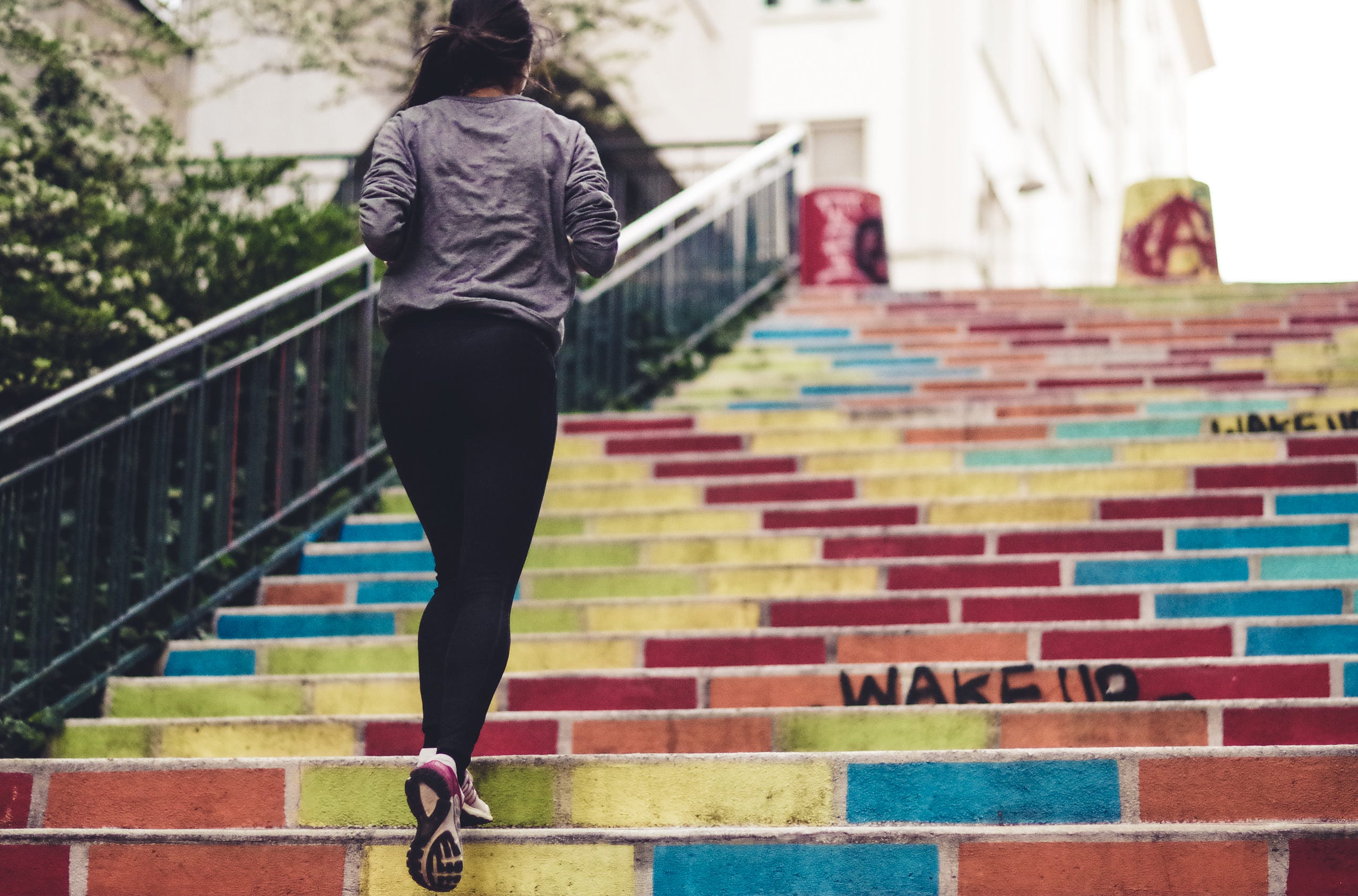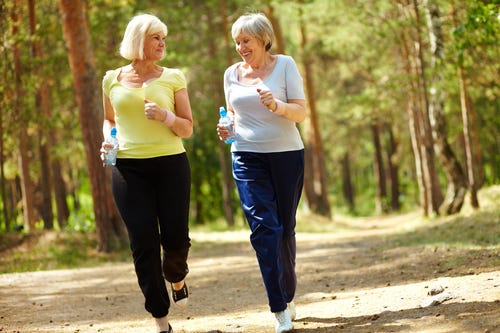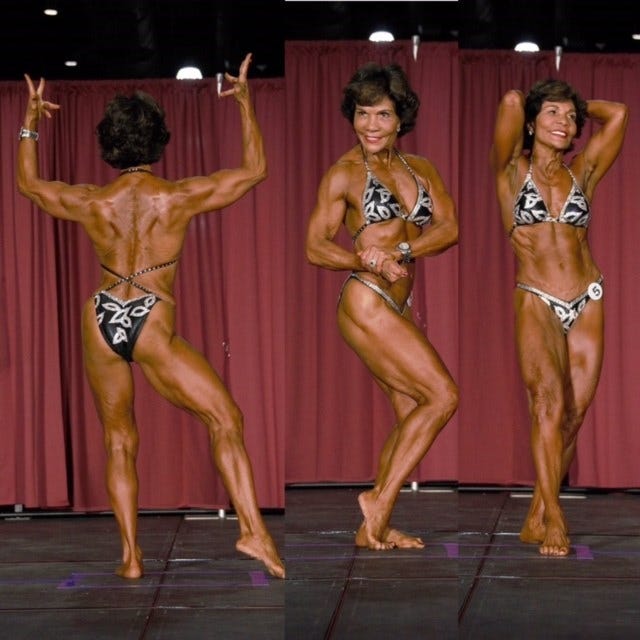
George was standing at the bottom of the first set of some 200 stairs when I caught up with him. Graying, compact, with a neatly-trimmed mustache, a very fit sixty, George is the perfect example of what so many men of that age would love to be: athletic, active, energetic.
Like me, George is a veteran. We stopped to chat on this breezy, cool Sunday, a lovely respite from the brutally hot weather we’ve been having. We’d just met earlier that morning through a mutual friend.
George exemplifies the discipline that so many of us veterans learn in basic training. I went through two of them: one as an enlisted woman and again as an officer. We were laughing that my sock drawer is still as neat as I learned to make it while in basic training back in 1974. While I’m naturally inclined towards physical activity, being a farm-raised kid, the Army taught me a great deal more about everyday discipline, goal-setting, and the absolute importance of maintaining fitness.

At sixty, which for far too many of us is an age where folks start to come up with excuses for why not to exercise, George regularly punches out steps and does the kinds of daily calisthenics that keep his body neat and tight. He exudes that coiled energy of people who feel good, look good and revel in superb fitness. It would be easy to mistake him for someone easily fifteen or twenty years younger were it not for the grey hair. He’s enthusiastic, happy and energized. His stomach is washboard flat, the envy of many an older man.
Last Sunday, as I jogged close to four thousand steps as part of my program to train to climb Mt. Kenya later this year, I passed another man who was clearly in his sixties or older. Sweat stained his t-shirt as he steadily ran the steps. For the better part of 90 minutes we passed each other silently. He was tall, stately, and again, flat-stomached. And determined.
Both of these men, along with several women of a Certain Age whom I also passed on the steps that day, remind me of why I keep at this game late in life. Each of these people was clearly enjoying themselves. Movement gives them pleasure, especially in such lovely surroundings out here in Colorado. But it’s not just the gorgeous rocks, trees and magnificent blue sky that make us happy. It’s the feeling we get from the effort, the natural endorphins that are within each and every one of us which are released when we push ourselves a bit.

As a writer as well as a professional speaker, a large part of my day is spent sitting in front of my computer.
Too many of us get sucked into the sickness of social media’s sick side and succumb to anger.
Companies can use that anger to sell us products that exacerbate that anger. Even further. Before I was hospitalized in Iceland 2015 for a smashed pelvis, I spent no time on Facebook at all but to post a few photos. Bored out of my gourd, I leapt in, and discovered how hard it was to wean myself off. It’s hugely addictive, and getting myself redirected in more positive directions has been challenging. I fully get how people can’t turn it off. But if we want happier lives, we must. The daily dose of anger, hopelessness and helplessness that Facebook serves up ages us faster than time itself. It sucks the very life right out of us. That’s why it’s so essential to mind where we spend our time.
We are a reflection of those with whom we associate (Jim Rohn). As some folks note, and they’re right, show me how you spend your day and I’ll tell you who you are. George’s body- at sixty- and the fitness of those older athletes that I pass regularly out at Red Rocks sport the results of regular, consistent exercise and careful eating. These people glow with health. Hanging with healthy people has a way of inspiring us to keep at it.
The most intimate of our associations ( again according to speaker Jim Rohn), the closest five, have the greatest impact on our self worth, our habits and our lifestyles. That speaks to being exceedingly picky. In other words, make one of them a dog (or cat or horse or all three).
In the early 1980s I traveled to New Zealand, a country blessed with some of the most breathtaking scenery on earth. I hiked the Routeburne Track on the South Island, and spent untold hours in the high country. Back then, still in my early thirties, I watched older couples pass me on the trail and hike far higher than I could at the time.
I remember thinking how badly I wanted to be like them.
Now I am one of those oldies.

In speaking with George and the other sixty-plus folks who run stairs on a gorgeous Sunday morning, there are a few habits which stand out among all of us:
- We stay away from doctors as much as possible. Many of us prefer to work with nutritionists and holistic healers. We also question and challenge anything a doctor prescribes and we do plenty of our own research. NOTE: I did NOT say don’t see doctors. I AM saying that the more we take care of ourselves the less we need them. And, be mindful that if you live in a for-profit medical country, the push to put you on more meds can sicken or kill you off. Question, research, know your body, know what to ask.
- We eschew prescriptions as much as possible. Most of us take few or no pills at all. By focusing on healthy choices we limit our need for intervention. I did NOT say go invest in woo-woo and crystals. Kindly. Avoiding prescriptions is just common sense. Finding well-researched alternative care (such as acupuncture, which, like chiropractic and massage, are now widely paid for-even the VA is on board with many of these, for they help prevent the need for toxic pain medication).
- We’re patient with our bodies. On one hand, we are happy to push past perceived limitations. On the other we respect how the body is changing with age, and make appropriate shifts. For example, we stretch more. Many of us do yoga. We don’t beat our bodies up, but rather check to see what’s what, and work with what we have. What this does is help prevent unnecessary injuries, while at the same time moving us past our boundaries.
- We eat carefully. The majority of our diets are designed with our unique bodies in mind. We recognize that as we age, our caloric needs drop unless we’re in training for an event. A FitBit isn’t an excuse to gorm a pizza. We’re far more aware of what works and what doesn’t. On the other hand, we also allow the periodic treat, which keeps the cravings in balance. For example I have a “stash cabinet” where I keep chocolates and other goodies. For the most part I hardly know it’s there. But when I have a craving for a chunk of dark chocolate or a big handful of smoked almonds, they are within reach. Knowing that I can have the occasional treat keeps me from downing an entire dozen Krispy Kremes, which is what we do sometimes when we discipline ourselves too much. We get resentful, and end up buying half the candy aisle.
- We find something physical that we absolutely love to do. For example, I recently met Sean Ongers, who is the head of Learning and Development for a very large corporation that one of my clients services. Sean is in his early forties, but competes in cricket with a vengeance. At an age when far too many people have already given up the discipline of regular exercise and opt for a pizza run rather than a run up the mountain and back, Sean’s involvement in his sport as a senior athlete (in your early forties, which tickles me no end) keeps him in top shape. He exudes energy and enthusiasm, which for so many knocking on the door of so-called “middle age” are already in the past. Whatever we do consistently is what we will look like. About 85% of our appearance is what we eat, and the rest is how much we’re willing to work on our bodies to make the most of the potential fitness it can give us, with all the attendant benefits. Sean’s habits, deeply ingrained as are George’s and mine, will set up him up to age extremely well.
- We never stop experimenting. Changing things up. Exploring. Finding new ways to engage our brains, bodies and emotional development. Rather than get into ruts, which become routines, which become habits, which invite boredom, we are constantly looking for inspiration, ideas and ways to explore. Every year I take on a new sport. Set a big goal. Have something ahead of me that interests me deeply. These things keep me very enthusiastic about what’s next, what’s possible, and what I can still accomplish at any age. Similarly, George simply exudes energy and positive enthusiasm. He feels good, looks good, and those gifts keep him in the game. He still feels he can accomplish just about anything, and he’s right. He can. Being in superb shape sets us up for success at all ages.
- We take the time to rest and recuperate. Long past our youthful excesses (at least most of them anyway), we now understand the critical need to relax, renew, and rejuvenate. That way we can hit the trails, the steps, the water, the ski slopes with all the energy of people a third our age.

Aging is inevitable. Mental, emotional and physical decrepitude aren’t. What makes the difference is a combination of attitude, discipline and a sense of humor and optimism about what’s possible. Those I see on my daily runs and exercise routines who, like me, sport plenty of gray don’t have time to complain about aging. We do make fun of it, and in the process, also make the most of it.
If you want help in shifting some of your habits, I recommend the super book The Power of Habit by Charles Duhigg. In it he discusses how habits are formed, how you can change yours, and how that can fundamentally change your life. It’s never ever too late. Two women who stand as motivation for me are Ernestine Shepherd, at 77, who is the world’s oldest female bodybuilder. She had never touched a weight before she was 59. The other is Dr. Josefina Monasterio, who competes in bodybuilding at the age of 72. She also had never started lifting until she was 59. These women are a reminder that we are never too old to learn to push ourselves, improve our health, and inject a huge blast of energy and joy into our lives.
Don’t like your body after sixty? You can make changes. Or you can buy into the false notion that decrepitude is normal. No it’s not. We have a set point for vibrant health, energy and productivity at any age. However, we have to earn it. For my part, and people like George, it’s worth it.
Comments powered by Talkyard.